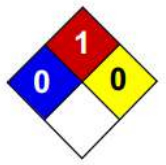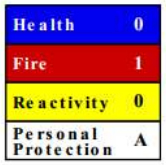 |
 |
 |
Safety Data Sheet 5602-02-02
1. PRODUCTION NAME AND COMPANY IDENTIFICATION
Product Name: 5702-02-02
Product Use: Various, Edible vegetable oil
Company Name:
AAK USA K1 LLC
Company Address:
2520 Seventh Street Road
Louisville, KY 40208
Date Issued: 9-2-15
Prepared by: Deborah McRoberts
Emergency Telephone Number 502-636-3712
2. COMPOSTION/INGREDIENT INFORMATION
Ingredients: Partially Hydrogenated Soybean Oil & Soy Based Emulsifier
Hazardous Components: None
CAS#: 8016-70-4
3. HAZARDS IDENTIFICATION
Routes of Entry
Eye Contact: No known hazard
Skin Contact: May cause irritation in sensitive individuals with prolonged exposure
Ingestion: Food Grade
Inhalation: Inhalation of fine mist may effect respiratory system
4. FIRST AID MEASURES
Eyes: Flush with plenty of water or eye wash solution for 15 minutes. Get medical attention if irritation persists.
Skin: Wash with soap and flush with plenty of water
Ingestion: Contact Physician if discomfort is encountered.
Inhalation: Remove to fresh air and seek medical attention.
Medical Conditions Generally Aggravated by Exposure:
Inhalation of product may aggravate existing chronic respiratory problems such as asthma,
emphysema or bronchitis. Skin contact may aggravate existing skin disease.
5. FIRE FIGHTING MEASURES
Flash Point (Method Used): Not Available
Flammable Limits
LEL: Not Establish
UEL: Not Establish
Extinguishing Media: Dry Chemical, Cabron Dioxide, Foam
Special Firefighting Procedures:
Cool containers exposed to flame with water. Limit the spread of oil. Treat as an oil (edible fat)fire. Use air supplied equipment for fighting interior fires. DO NOT USE WATER TO EXTINGUISH.
Unusual Fire & Explosion Hazard
As with all unsaturated fats and oils, some porous materials such as rags, paper, insulation or clay when wetted with this product may undergo spontaneous combustion. Keep such wetted materials well ventilated to prevent possible heat buildup.
Hazardous Decomposition Materials: CO, CO2
6. ACCIDENTAL RELEASE MEASURES (STEPS FOR SPILLS) Methods for Cleaning Up:
Absorb onto an inert, absorbent substrate and sweep. Wash area with soap water.
Floors will be slippery; take precautions.
7. HANDLING AND STORAGE
Handling
Safe Handling: Avoid direct or prolonged contact with skin and eyes. Avoid breathing oil mist.
Storage
Requirements for Storage Areas and Containers:
Store in an area that is cool, dry, and well-ventilated.
8. EXPOSURE CONTROL/PERSONAL PROTECTION
Introductory Remarks:
These recommendations provide general guidance for handling this product. Because specific work environments and material handling practices vary, safety procedures should be developed for each intended application. While developing safe handling procedures, do not overlook the need to clean equipment and piping systems for maintenance and repairs. Waste resulting from these procedures should be handled in accordance to the section entitled Disposal Considerations.
Exposures Guidelines:
Engineering controls are usually not necessary if good hygiene practices are strictly followed. Respiratory protection is generally not required during normal operations. Wear the following to prevent skin contact: work pants, long sleeve work shirt, and work gloves. Where there is the danger of eye contact, wear splash proof goggles.
Threshold Limit Value: Not Available
Work Practice Controls:
Personal hygiene is an important work practice exposure control measure and the following general measures should be taken when working with or handling this material:
1) Do not store, use, and/or consume foods, beverages, tobacco products, or cosmetics in areas where this material is stored.
2) Wash hands and face carefully before eating, drinking, using tobacco, applying cosmetics, or using the toilet.
3) Wash exposed skin promptly to remove accidental splashes or contact with this material.
9. PHYSICAL AND CHEMICAL PROPERTIES
Physical State: Flakes
Color: Creamy White
Odor: Characteristic, bland, fatty oil
Vapor Pressure (mm Hg.): N/A
Vapor Density (AIR = 1): -
Boiling Point: N/A
Melting Point: 113-119°F
Peroxide Value: 1.0 Max
FFA: 0.05 Max
Specific Gravity (H2O=1): 0.698-0.921
Evaporation Rate: N/A
Solubility in Water: Insoluble
Water Reactive: No
10. STABILITY AND REACTIVITY
Stability: This material is stable under normal conditions described in that section.
Incompatibility (Materials to Avoid): None
Conditions to Avoid: None
Hazardous Decomposition or byproducts: CO,CO2
Hazardous Polymerization: Will Not Occur
11. TOXICOLOGICAL INFORMATION: No Information
12. ECOLOGICAL INFORMATION: No Information
13. DISPOSAL CONSIDERATIONS Waste Disposal Methods:
Chemical additions, processing or otherwise altering this material may make the waste management information present in this MSDS incomplete, inaccurate or otherwise inappropriate. Please be advised that state and local requirements for waste disposal may be more restrictive or otherwise different from federal laws and regulations. Consult state and local regulations regarding the proper disposal of this material.
14. TRANSPORT INFORMATION
DOT Shipping Name: Not regulated
15. REGULATORY INFORMATION: No Information
16. ADDITIONAL INFORMATION:
This information is provided for documentation purposes only.
This product is not considered hazardous.
The complete range of conditions or methods of use are beyond our control therefor we do not assume any responsibility and expressly disclaim any liability for any use of this product.
Information contained herein is believed to be true and accurate however, all statements or suggestions are made without warranty, expressed or implied, regarding accuracy of the information, the hazards connected with the use of the material or the results to be obtained from the use thereof. Compliance with all applicable federal, state, and local laws and local regulations remains the responsibility of the user.
This safety sheet cannot cover all possible situations which the user may experience during processing. Each aspect of your operation should be examined to determine if, or where, additional precautions may be necessary. All health and safety information contained in this bulletin should be provided to your employees or customers.
